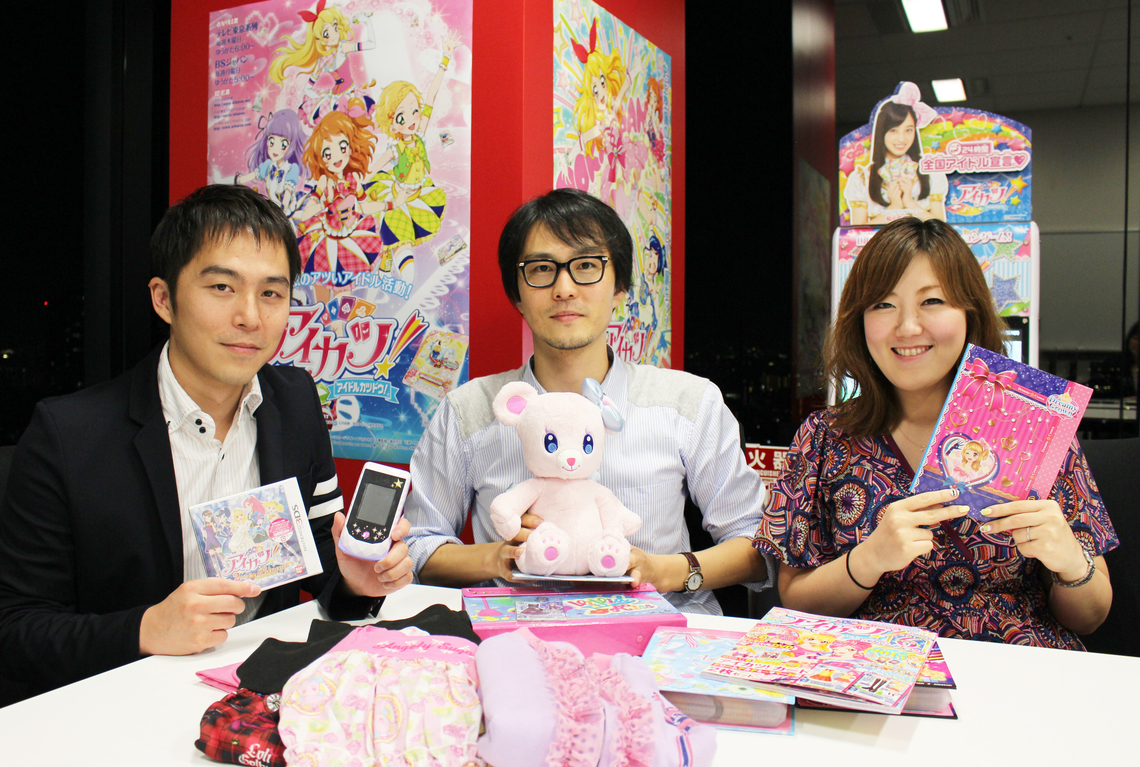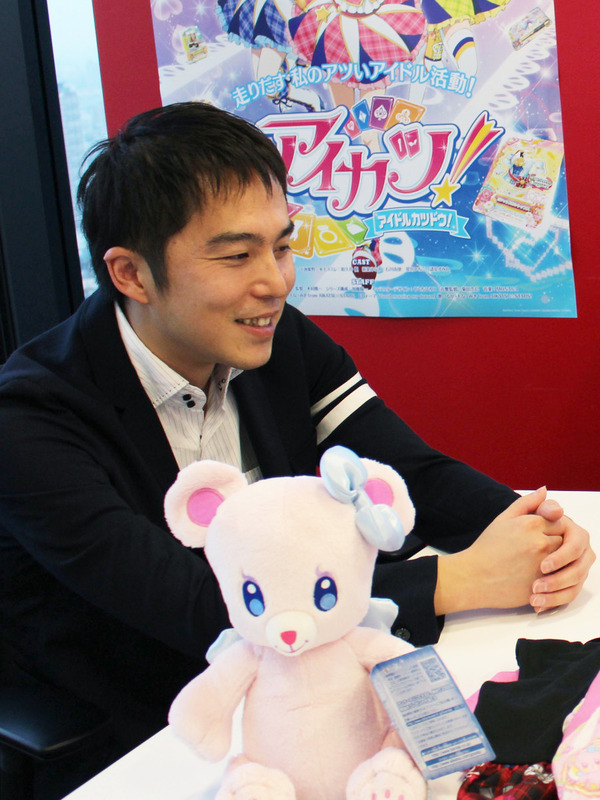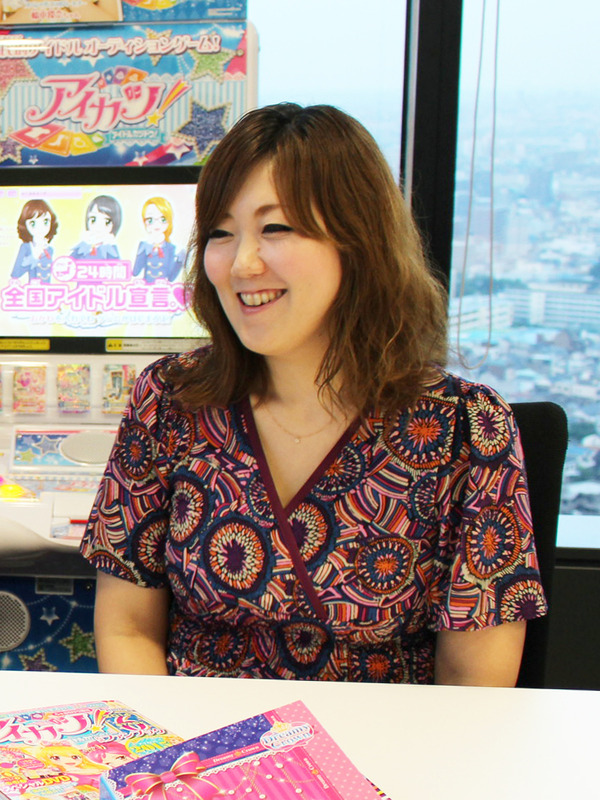イオンモールに設置されたカードゲーム機に列をなす小学校低学年の女児たちとその親。「アイカツ!―アイドルカツドウ!―」が登場してから2年、ゲーム機・データカードダスで使用するカードの総出荷数は1億枚を突破した(2014年3月現在)。アイカツ!はゲーム、アニメ、ウェブ、そしてグッズ展開と、メディアミックス戦略で女児たちの生活の中に浸透した。アイカツ!はなぜここまで大きなブームになったのか。女児を夢中にさせる世界観のつくり方、ブランディング戦略について、バンダイでアイカツ!のカードゲームを統括する廣瀬剛氏、グッズ展開を手掛ける同社の橋本佳代子氏、そしてアニメのプロデューサーであるサンライズの伊藤貴憲氏にお話を伺った。

──女児にカードゲームがここまで受け入れられた理由はどこにあるのでしょう。
廣瀬:アイカツ!は、カードによるファッションコーディネートとリズムゲームを組み合わせた100円で遊べるゲームです。「国民的アイドルオーディションゲーム」と銘打って、ゲームを通してトップアイドルを目指すというストーリーになっています。
カードゲームは、これまで男児中心の遊びでした。今回、小学校低学年の女児をターゲットにするに当たって最も気を付けた点が「リアル志向」。男児に比べて女児は精神年齢が高くヒーローものなどのいわゆる「なりきり」は子どもっぽいと避けてしまう傾向があります。そこで現実に存在するアイドルという職業、オーディションという仕組みをつくってゲームの世界を楽しんでもらうことを目指しました。
橋本:女児のなりきりとして「プリキュア」がありますが、これは未就学の女児まで。小学校に上がるタイミングで卒業して、ファッションなど大人っぽいものに興味を持ち始めます。プリキュアは幼稚園で卒業、小学校入学でアイカツ!という住み分けができてきました。
廣瀬:またアイドルという存在が身近な存在になっていることも大きいです。アイカツ!のプロモーションでは、スペシャルコラボパートナーとして板野友美さん、島崎遥香さんを起用してきました。もともと女の子はアイドルに憧れますが、時代性としてアイドルとの距離感が近づいたことで、現実的な憧れの対象になっているのです。
──アニメの方はいかがでしょうか。
伊藤:アニメではスターライト学園という学校を舞台に中学生の女の子たちが切磋琢磨してアイドルを目指します。1、2年目は星宮いちごちゃんを中心にストーリーが展開しましたが、3年目は大空あかりちゃんが中心になります。
コアターゲットが小学1~3年生なので、劇中で話す言葉も分かりやすく、それでいながら一緒に見る親でも楽しめるような普遍的なストーリーにしています。アイカツ!はゲームとアニメのどちらから入っても違和感なく楽しめるように世界観を統一していますが、今回のターゲットである小学校低学年の女児というのは、アニメもゲームもグッズも純粋に楽しめるちょうどよい世代なのかな、と感じますね。それより上の世代になるとアニメはこっそり見ても、ゲームやグッズは恥ずかしい、逆にグッズは集めてもアニメは見ないというようになりやすいので。
廣瀬:登場人物が中学生というのも、ターゲットとしている女児にとってはちょうどいい背伸び感がある憧れの対象になっています。これが高校生だと自分たちの想像の先にいってしまい、大人のもの、自分たちには早いと、敏感に感じて興味を持たなくなってしまいますから。
──アニメに登場するグッズも女児たちに大人気ですね。
橋本:アニメの中には、キュート、ポップ、クール、セクシーなどの個性を持った複数のファッションブランドが登場します。登場するキャラクターにも得意なブランドコーデというのがあって、ファッションが個性をさらに際立たせます。
ですので、アイカツ!で展開するファッショングッズは、キャラクターものの服ではなくて、そのアニメに登場するブランドの本物のファッションとして展開しています。ストーリーでもキャラクターはドレスが欲しくてアイカツ!を頑張るので、その世界観はゲームでアイカツ!をする子どもたちとも共通になっています。
伊藤:ファッション以外のアイテムについてもスターライト学園に登場するものを意識してグッズ展開しています。アニメ制作のスケジュールと商品開発のスケジュールは全く別物なので、調整するのが大変なのですが…。どんな商品を企画しているか、どんなことができるか、どんな名前か、という素案の段階から情報を共有してもらい、ストーリーの中に入れていきます。アニメにアイテムが登場したらその翌日には同じアイテムを子どもたちが手に入れることができ、喜んでもらえるのが理想です。可能な限り商品展開とストーリーが連動するようにしていて、常日頃からプロジェクトチーム全体で密にコミュニケーションをとってタイミングを逃さないようにしています。
橋本:バンダイ側から提案することも多いのですが、アニメの方からこういうことをやりたいというお話もあって、それを商品に生かすこともありますよ。
伊藤:単純にアニメの中で商品を紹介して売るというキャラクターマーチャンダイジングではなくて、将来的にストーリーがこうなるから、こういうアイテムがあると番組演出がしやすいというようなことをお伝えして、商品開発に生かしてもらっていますね。
廣瀬:ゲームも2カ月に1回更新して新しいファッションや曲で遊べるようになっており、こちらもアニメと連動しています。アーケードゲームにおいて、このスピード感で更新するものはこれまでありませんでした。
ありがたいのは、提案や面白いネタは、ゲーム、アニメ、グッズのチームがお互いに全力で拾って、面白く仕上げてもらえること。チームとしての結束が強いプロジェクトで、お互いのフォローができるから、こうした展開が可能になっていますね。

──アイカツ!のブレークポイントはどこにあったのでしょうか。
廣瀬:2012年10月にスタートして、その年末くらいからブームの兆しを感じ始めました。「アイ!カツ!アイ!カツ!」と口ずさみながら歩く子どもの姿が目撃されたり、認知度が上がったなとプロジェクトの中でも話題になりました。冬休みに入って今までゲームで遊びたいと思っていた子たちがわっと遊ぶようになったのでしょう。
本物のブームになったなと感じたのは、2013年の2月上旬くらい。データカードダス アイカツ!は、1年が6弾に分かれているのですが、1年目の第3弾の時に急激に広まりました。その年の春休みに、全国のイオンモールを回るイベントを開催したのですが、想像を超える1万6000人(5会場合計)くらいのお客さまに来場いただき、モールに入り切れないほどになってしまいました。
夏には商品が欠品になる、ショップをオープンすれば大行列になるというようにアイカツ!への熱量が上がりました。
伊藤:ブームを牽引しているキャラクターというと、第3弾で登場した藤堂ユリカが大人気です。ユリカ様と呼ばれています。また、霧矢あおいというキャラクターの決めぜりふである「穏やかじゃない!」という口癖をまねる子も増えましたね。
橋本:ユリカ様と一緒に登場したゴシックロリータのファッションブランド「LoLi GoThiC」というブランドも大人気になりました。子どものファッションの場合、大人の流行から5~6年くらい後に流行する傾向があるのですが、ゴスロリもまさにそのタームに乗った感じです。大人には当たり前になったゴスロリというファッションが子どもたちには珍しく見えて受け入れられたのだと思います。
伊藤:ユリカ様は普段は控えめな女の子なのですが、アイドルになるとゴスロリな見た目で、吸血鬼キャラに変身します。日常生活からアイドルに変化するその振り幅が一番大きいので、そういうところの面白さも人気の理由でしょうね。
次回(10/15更新予定)は、メディアミックスを成功させるための施策や、気になる今後の展開についてもお伺いします。










